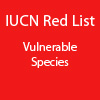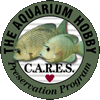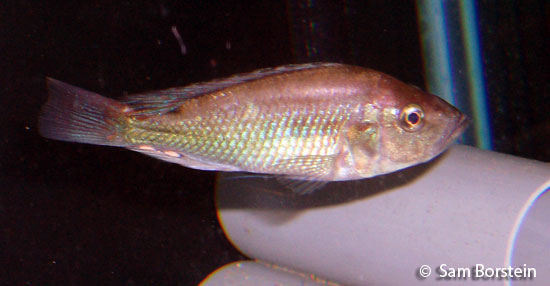Pyxichromis orthostoma
(Regan, 1922)
Largemouth Haplochromis
Synonyms: Haplochromis orthostoma, Prognathochromis orthostoma



Above: A male Pyxichromis orthostoma. Photo by Sam Borstein.
Etymology:
Genus- Pyxo= rump (Greek), chromis= a fish, perhaps a perch (Greek).
Species- orthostoma= large mouth (Greek).
Intro:
Pyxichromis orthostoma is a really cool predatory hap from the satellite lakes of Lake Victoria. This piscivore, with a very large mouth is on the IUCN red list and is a vulnerable species. It is rather new to the hobby. Although not extremely colorful, a distinctive look and body shape make the Largemouth Haplochromis an interesting aquarium resident.
This is a very interesting looking ambush predator and reminds me of a Lake Victorian version of a Snook Cichlid, Petenia splendida.
Distribution:
Pyxichromis orthostoma occurs in Lake Nawampsa and Lake Kyoga in the Lake Victoria basin.
Size, Maturity, and Sexual Dimorphism:
Size: Males- 8 inches, Females- 7 inches
Maturity: 3 inches
Sexual Dimorphism: Males are larger than females and have more colorful than the females which are silver. Males are greenish with a red back. This coloration is really evident during spawning.
Care:
This fish is not very aggressive, but will eat any fish that can fit in its mouth. I recommend only keeping fish similar in size to this species as they will look at anything half their size or smaller as food. The fish should be put in a large tank as they like to swim around a lot and will chase each other. Males are not very rough on the females. Decorate the tank with rocks and tall plants like Vallisneria.
As far as tankmates are concerned, I had luck with mild Malawian Haps and mbuna.
Diet:
This fish is a piscivore in the wild so a diet with a lot of protein is good. It is an ambush predator. Don't feed to much as I think the fish can have some digestive issues if fed to much protein, so make sure you mix in a good vegetable flake or pellet also. Any live food fed to the fish is happily accepted with greed.
This fish can get overambitious when eating, so don't feed anything to large as it can injure the fish's jaws, which aren't very strong.
Breeding:
This fish can be difficult to get going, but once started is hard to stop. Females can be difficult to condition up, especially if they are being harassed by the males. Spawning takes place in the typical T position for Victorian cichlids usually at the base of a rock.
Females are good holders and hold for about 18-20 days. The fry are small and numerous. Spawns range from 25-75 eggs. The fry are not problematic to raise and do great on newly hatched baby brine shrimp. The only issue I ever encountered when raising the fry was that they can be cannibalistic. The best way to counter this is try to feed a few times a day and feed enough to ensure all the fish get food. This will hopefully help with a more even growth pattern and less cannibalism.
Conclusion:
This fish is pretty hard to find. I've only seen it available from hobbyists. You won't find it in a pet shop and it truly is a hobbyists fish. This fish is not usually expensive and if you are a Lake Victorian cichlid fan, pick up a group of these. It is a very interesting species to keep.
References:
- IUCN. IUCN Red List of Threatened Species. <http://www.iucnredlist.org>.
